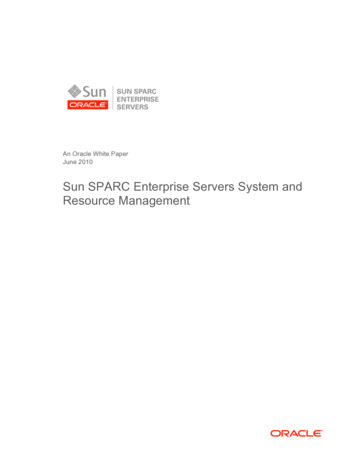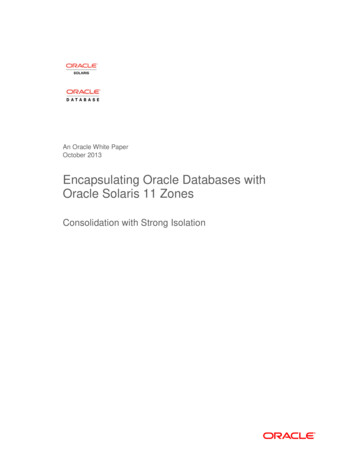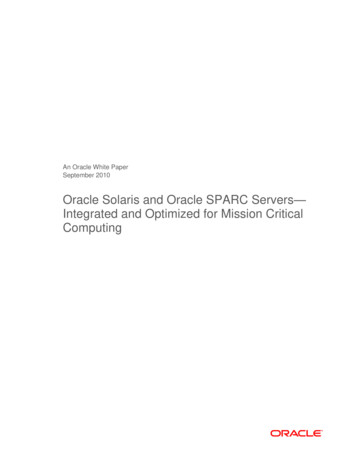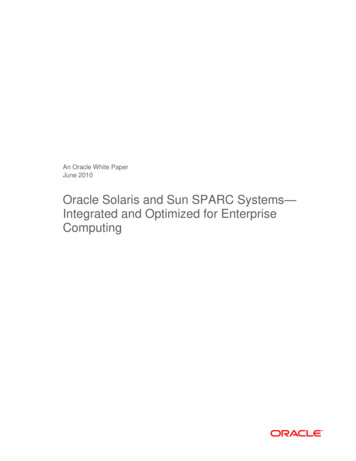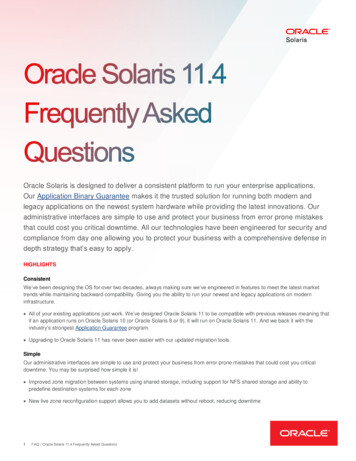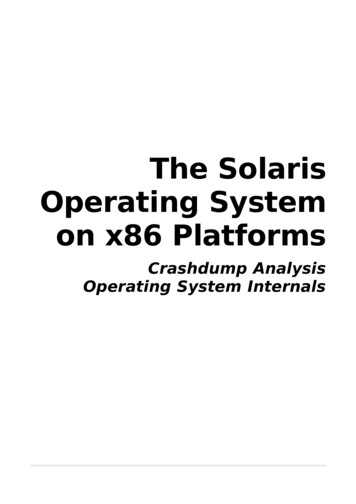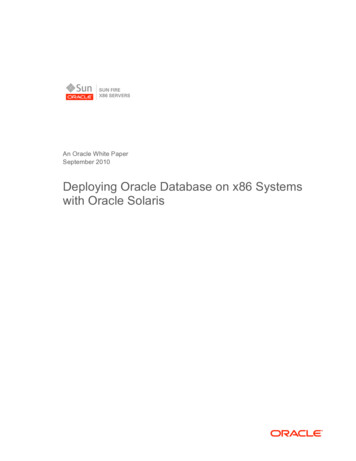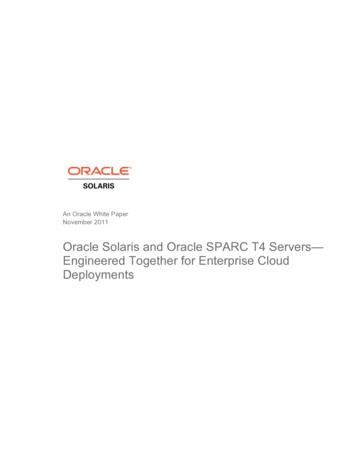
Transcription
An Oracle White PaperNovember 2011Oracle Solaris and Oracle SPARC T4 Servers—Engineered Together for Enterprise CloudDeployments
Oracle Solaris and Oracle SPARC T4 Servers—Engineered Together for Enterprise Cloud DeploymentsExecutive Overview . 1Introduction. 1SPARC T4 Processor and System Overview. 3SPARC T4 Systems Portfolio . 4Oracle Solaris and SPARC T4 servers. 4Performance . 5Benchmarks. 5Efficiency . 6Security. 6Availability. 7High Availability . 8Virtualization . 10Oracle Solaris 11 – Built for Clouds. 11Easy to Integrate – Cloud Ready. 11End-to-End Optimization . 11Easy to Deploy and Manage . 12Oracle Enterprise Manager Ops Center . 13Summary . 14Resources . 14
Oracle Solaris and Oracle SPARC T4 Servers—Engineered Together for Enterprise Cloud DeploymentsExecutive OverviewOracle Solaris and the SPARC T4 processor have been engineered together to improvethroughput, security, and resiliency throughout the application solution stack. Learn how thiscombination can maximize return on investment and help organizations manage costs for theirexisting infrastructures or for new enterprise cloud infrastructure design.IntroductionWith the trend to evolving enterprise datacenters into an internal cloud resource, manyorganizations are grappling with how to transform their existing infrastructure to offer theperceived economy and flexibility of the cloud computing model. Some organizations are eventhinking about completely redesigning the way they deliver services.Oracle Solaris has been helping organizations evolve their datacenters toward a moreservice-oriented model by modernizing datacenter computing, networking, and storagemanagement. Beginning with Oracle Solaris 10, this new design approach has resulted in anumber of new technologies that help organizations make the most of their datacenter assets.Amongst these key innovations are built-in virtualization for the operating system with OracleSolaris Zones (previously known as Containers), storage virtualization through the ZFSfilesystem and the ability to safely analyze live production workloads using dynamic tracing(DTrace). In addition, resiliency of system hardware and software services was significantlyimproved by the self healing capabilities introduced through the Fault ManagementArchitecture (FMA) and Service Management Facility (SMF).With the advent of Oracle Solaris 11, significant new capabilities build on this baseline toimprove traditional datacenter operations and pave the way to building enterprise-class clouds.Here the focus has been on enhancing and accelerating the ability to deliver services throughextending virtualization capabilities to the network and the introduction of new installation andsoftware management technologies.1
Oracle Solaris and Oracle SPARC T4 Servers—Engineered Together for Enterprise Cloud DeploymentsOver the last 25 years, the Oracle Solaris has been developed hand-in-hand with systems builtaround the SPARC processor. Oracle Solaris is tightly integrated with the many system levelcapabilities of the SPARC T4 processor, providing scalable, high-performance computecapability coupled with integrated high-speed networking and cryptographic acceleration.Today, with Oracle Solaris 10 and SPARC T4 systems, existing applications can receive animmediate performance boost and at the same time companies can begin extending theiroperations into the cloud with Oracle Solaris 11.The remainder of this paper provides further details of how Oracle Solaris and its companionproducts Oracle Solaris Cluster and Oracle Solaris Studio work together with SPARC T4systems and Oracle enterprise software to enable a compelling set of cloud-ready solutions.2
Oracle Solaris and Oracle SPARC T4 Servers—Engineered Together for Enterprise Cloud Deployments“Our benchmark testing of Oracle’s SPARC T4 system on our ERP System led to impressive results. We saw performanceenhancements of up to 4x compared to our legacy server. Deployment was easy; just a drop in. Our planned worldwide rolloutwill take advantage of the SPARC T4’s very modest space, energy and heat requirements. In our production deployment weplan to use Oracle Solaris virtualization to implement containers and consolidate several workloads onto a single server.”Thomas Kleber, Department Lead IT, Kromberg & Schubert GmbH & Co,SPARC T4 Processor and System OverviewThe SPARC T4 processor marks a significant breakthrough in performance and energy efficiency tomeet the demanding challenges of today’s increasingly virtualized datacenter. The latest multithreadingtechnology delivers not just the throughput computing capability of its predecessors, but also up to 7xbetter performance for single threaded workloads. As an example, 64 threads can be supported in tworack units (2RU), providing increased computational density while staying within variously constrainedenvelopes of power and cooling. Very high levels of integration help reduce latency, lower costs, andimprove security and reliability. Optimized system design provides support for a wide range of ITservices application types. Uniformity of management interfaces and adoption of standards help reduceadministrative costs, while an innovative chassis design shared across Oracle’s volume servers providesdensity, efficiency, and economy for modern data centers.The SPARC T4 processor family is designed and optimized to address a variety of applicationenvironments. Table 1 provides an overview of the key features of the SPARC T4 processorarchitecture.TABLE 1. KEY FEATURES OF THE SPARC T4 PROCESSOR ARCHITECTUREFEATURESPARC T4 SPECIFICATIONSCores/Threads/SocketsUp to 8 cores/8 threads/4 socketsUp to 256 processing threadsChip Multithreading (CMT)Maximum frequencyUp to 3.0 GHzShared L3 cache4 MB on chipDedicated L2 cache (128KB per core)On-chip supportPCI Express bridge, integrated dual 10GbEnetworking with XAUI, crypto acceleration,L1, L2 and L3 cache, integer and floatingpoint execution units, PCIe Gen 2 (x8),hypervisor3
Oracle Solaris and Oracle SPARC T4 Servers—Engineered Together for Enterprise Cloud DeploymentsMaximum memory (per system)Up to 1,024 TB (4 sockets)Reliability featuresPredictive Self Healing, hot-swapcomponents, ECC everywhere, redundantcomponents and networking, hot pluggingof PCIe, USB, and SCSI devices.SecurityMultiple on-chip cryptographic capabilities,plus additional protectionsVirtualization (V12N)Oracle VM Server for SPARC (previouslyIncluded at no extra chargecalled Logical Domains or LDOMs) andOracle Solaris zonesTarget environmentsNetwork-facing: consolidation andvirtualization, Web, Media, security, OLTP,middleware/SOA, batch processing,datamart, application serversSPARC T4 Systems PortfolioProviding a seamless upgrade path for existing SPARC systems, Oracle offers three rack-mountconfigurations and one blade server. The blade server has a single CPU and is compatible with the SunBlade 6000 Modular System chassis. The rackmount systems are offered in 1,2 and 4 socketconfigurations.Oracle Solaris and SPARC T4 serversOracle Solaris is a proven, industry-leading operating system with features designed to handleenterprise, business-critical operations. Oracle Solaris provides key functionality for virtualization,optimal utilization, high availability, unparalleled security, and extreme performance for both verticallyand horizontally scaled environments. Oracle Solaris runs on a broad range of SPARC (and x86-based)systems and compatibility with existing applications is guaranteed. This is why there are over 55,000businesses and institutions running over 11,000 certified applications on Oracle Solaris today.With Oracle Solaris at it’s heart, Oracle offers customers a complete integrated stack, from theapplications layer at the top to disk storage systems at the bottom, as shown in Figure 1. Oracle is thenumber one vendor in the top three software segments (applications, middleware, and database), andOracle Solaris is the number one deployment platform for Oracle Database applications.4
Oracle Solaris and Oracle SPARC T4 Servers—Engineered Together for Enterprise Cloud Deployments“As a leading global financial institution, ING needs servers that provide the highest levels of reliability and performance tosupport our mission-critical business applications. Our testing of the ING application stack on Oracle’s SPARC T4 serversrunning Oracle Solaris proves Oracle’s Sun servers deliver quality, predictability and complete backwards compatibility whilegreatly enhancing system performance.”Frank Schots, Senior UNIX Systems Engineer, ING BankFigure 1. Oracle Solaris and Oracle’s SPARC servers are the optimal solution stack for Oracle Database andApplications.PerformanceOracle’s SPARC T4 systems integrate many technologies. Table 1 indicates features with the CPU itselfsuch as networking and cryptoacceleration. The systems also include a service processor (iLOM) andsubsystems for memory and I/O. Oracle Solaris is designed to deliver a first-class environment forrunning enterprise applications by leveraging the capabilities of the underlying hardware.The multithreaded capabilities of Oracle Solaris leverage the redesigned core of the SPARC T4processor. In particular, a thread can now be defined as “critical” and consume all the resources of acore resulting in a significant performance boost for single threaded applications. This is in addition tothe throughput computing capabilities inherited from previous generations of T-series processors.BenchmarksFollowing on from the many world class performance results set by earlier generations of SPARCsystems, the T4 has, in short order, shown impressive performance across a range of benchmarks.Performance improvements in both single-threaded and throughput computing allow the T4 tocompete effectively against IBM’s Power and Intel’s x86 and Itanium CPUs as illustrated in the tablebelow.5
Oracle Solaris and Oracle SPARC T4 Servers—Engineered Together for Enterprise Cloud DeploymentsApplicationBenchmarkResult/notesFusion MiddlewareSPECjEnterprise20102.4x faster than IBM Power7E-Business SuiteHR R12.1.22400 online usersPeoplesoft PayrollBatch3.1x faster than HP ItaniumPeoplesoft HRHR Self-Service 9.13.8x faster then IBM PowerSiebelLoyalty Batch7.65M TPH (Reward Accrual)JD Edwards“Day in Life” online batch2.5x faster than IBM Power7P750Communications ActivationTelco provisioningT4 CPU 7.7x faster than1.7GHz ItaniumCommunications Service BrokerTelco (Java/IntelligentNetworks)T4 CPU 2.7x faster than IntelNehalemDatabaseSecurity TDE42% faster than Intel AES-NIimplementationDatabaseTPC-HFaster then IBM Power7 780and HP ItaniumEfficiencyThere are many areas where the OS and hardware interoperate to maximize efficiency. Oracle Solarisrecognizes SPARC T4 system power management settings to optimize system power consumption. Inaddition the software components responsible for networking and cryptography will utilize hardwareresources rather than wasting CPU resources to implement the various packet processing and securityalgorithms. This allows for wire-speed encryption without impacting critical workloads and this “free”encryption is also utilized by both Oracle Solaris ZFS for on-the-fly encryption and for secure livemigration in VM Server for SPARC as described below.SecurityOracle Solaris provides a sophisticated network-wide security system that controls the way users accessfiles, protect system databases, and use system resources. Oracle Solaris provides security features suchas labeled security, previously only found in the Trusted Solaris 8 OS. It delivers a secure environmentright out of the box. Oracle Solaris offers RBAC (Role Based Access Control), Process RightsManagement, and least privilege. These technologies reduce security risk by granting users andapplications only the minimum capabilities needed to perform tasks. System administrators can grant—or deny—a large number of discrete privileges to any process on the system to create effective security6
Oracle Solaris and Oracle SPARC T4 Servers—Engineered Together for Enterprise Cloud Deploymentspolicies, minimize the likelihood of hostile actions, control access to data, and ensure compliance withregulatory requirements.Close integration with hardware provides the following: SPARC T4 processors include an integrated cryptographic accelerator unit in each of the eight cores.This means Oracle Solaris applications can run securely without the extra cost of a separatecryptographic processor, and without the CPU overhead associated with secure operation. SPARC’sintegrated cryptographic units support seventeen of the most common ciphers and secure hashingfunctions and they outperform solutions based on add-in accelerator cards by more than 10x. Symmetric key-based encryption and decryption mechanisms, such as Data Encryption Standard(DES), Triple DES (3DES), Advanced Encryption Standards (AES-128, AES-192, and AES-256),MD5, SHA1, SHA-224, SHA256, SHA-384/SHA-512 and Elliptic Curve Cryptography (ECC)mechanisms, such as the ECCp-160 and ECCb-163 and Galois Field Operations. An on-chipRandom Number Generator supports random number generation operations intended forcryptographic applications RSA operation. This is an important component of the Secure Sockets Layer/Transport LayerSecurity (SSL/TLS) full handshake. Each core of the SPARC T4 processor includes a ModularArithmetic Unit (MAU) that supports RSA and Digital Signature Algorithm (DSA) operations. RSAoperations utilize a compute-intensive algorithm that can be off-loaded to the MAU. In SPARC T4processors, moving RSA operations to the MAU speeds SSL/TLS full handshake performance andfrees the CPU to handle other computations.AvailabilityOracle Solaris Predictive Self Healing software proactively monitors and manages system componentsto help organizations achieve maximum availability of IT services. Predictive Self automaticallydiagnoses, isolates, and recovers from many hardware faults and provides resiliency for softwareapplications. This enables system services to continue uninterrupted in the event of software failures,major hardware component failures, and even misconfigured software. The Oracle Solaris FaultManager Architecture (FMA) and Oracle Solaris Service Manager Facility (SMF) are the two maincomponents of Predictive Self Healing.FMA automatically diagnoses faults in the system and initiates self healing actions to help preventservice interruptions. This feature reduces downtime by configuring problem components out of asystem before a failure occurs—and in the event of a failure, this feature initiates automatic recoveryand application re-start using SMF. The FMA diagnosis engine produces a fault diagnosis oncediscernible patterns are observed from a stream of incoming errors. Following diagnosis, FMAprovides fault information to agents that know how to respond to specific faults. On systems whereASR (Oracle Auto Service Request) is running, a fault notification will cause a service request to beraised. This service is fully integrated with My Oracle Support and helps provide faster problemresolution.7
Oracle Solaris and Oracle SPARC T4 Servers—Engineered Together for Enterprise Cloud DeploymentsFMA offers comprehensive reliability and availability capabilities on all Oracle SPARC T4 systems. Forexample: CPU “offlining” takes cores and threads (strands) deemed faulty offline. The system will continue tooperate in this condition, albeit with slightly degraded capacity, until a repair can be effected. Memory page retirement retires pages of memory marked as faulty. They are recorded and remainoffline on reboot until the faulty memory has been replaced. Cache line retire – this feature retires one or more 64 byte lines of L2 or L3 cache which have beendiagnosed as faulty within a processor chip, preventing those lines from generating further ECCerrors. They are recorded and remain offline on reboot until the faulty processor has been replaced,at which point they are made available again. Retirement of small numbers of cache lines haveminimal effect on system performance, while allowing the system to continue in service withoutrequiring an outageThe SMF facility creates a standardized control mechanism for application services by turning theminto first-class objects that administrators can observe and manage in a uniform way. These serviceswill be automatically restarted even if they are accidentally shut down by an administrator, aborted asthe result of a software programming error, or are interrupted by an underlying hardware problem.Specifically, SMF enables administrators to do the following tasks easily and efficiently with OracleSPARC servers running Oracle Solaris: Configure and manage services for automatic restart, bringing processes back online after a failure inthe correct order of dependency Diagnose and repair “misbehaving” or failed services Preserve enabling/disabling of services across system upgrades and patches Ensure compatibility with legacy services which may still use traditional Unix startup scripts Automatically generate snapshots of the service configuration repository to allow for backup,restore and undo operations on the set of system services. Provide consistent configuration handling for a range of entities such as network devices andaddresses and kernel configuration informationHigh AvailabilityA single instance of Oracle Solaris offers a number of availability features, including FMA, networkand storage multipathing and hot-swap capabilities. However some applications require an additionallevel of availability which can only obtained by tightly coupling together multiple server units throughan advanced OS based clustering solution. Oracle Solaris Cluster is the clustering solution designed forOracle Solaris and optimized to leverage the SPARC T4 reliability features. , Through its tightintegration with the Oracle Solaris kernel, it enables rapid failover in the event of a problem with onenode in a cluster. This close integration encompasses many other aspects of the OS, in particularvirtualization where Oracle Solaris Zones and Oracle VM server for SPARC instances can be clustered,8
Oracle Solaris and Oracle SPARC T4 Servers—Engineered Together for Enterprise Cloud Deploymentsallowing multi-tier application environments to be consolidated across a cluster. Both type of virtualinstances can be used as closed entities where the clustering framework considers them as black boxesand moves them across servers triggered by component failures or operator commands. They can beconfigured as “normal” cluster nodes with fine-grained control of applications components anddependency management. In the case of Oracle Solaris Zones an additional option is offered: the zonecluster. This configuration extends the Oracle Solaris Zones model to a virtual cluster. It provides Security isolation. Applications and users within one zone cluster cannot see or access data orapplications running in a different zone cluster. Application fault isolation. Actions taken by applications within a zone cluster, such as issuing areboot command, do not affect applications outside of that zone cluster. Resource management. Resources, or shares of resources, can be allocated to a zone cluster. Thisincludes resources such as CPUs, memory, devices, and file systems. Dedicated cluster model. Zone clusters provide the illusion that the zone cluster is a traditionalcluster dedicated for the use of cluster applications within that zone cluster. The applications arenot aware of any other clusters on that hardware.Those characteristics make the zone cluster the perfect environment to consolidate multiple clusterapplications or multi-tiered workloads onto a single physical cluster configuration. It offers : Full service protection through fine-grained monitoring of application, policy-based restart andfailover within virtual cluster Reliable operations of multi-tiered workloads through management of dependencies across zonesclusters Ease of use and administrative isolation through delegated administration extended to virtualcluster9
Oracle Solaris and Oracle SPARC T4 Servers—Engineered Together for Enterprise Cloud DeploymentsFigure 2. Clustering of zones provides a highly available multi-tier application environmentWhere Disaster Recovery is needed Oracle Solaris Clusters also offers support for business continuitywith campus-wide or multi-site, multi cluster configuration delivering automated failover ofapplications and data integrity through coordination with application-, host- and storage basedreplication.VirtualizationOracle supports OS and server virtualization technologies, each of which provide different degrees ofisolation, resource granularity, and flexibility. These capabilities are built into Oracle Solaris and OracleSPARC servers—there are no additional costs to use them. Oracle VM Server for SPARC, previously called Sun Logical Domains, leverages the built-in SPARChypervisor to subdivide supported platforms' resources (CPUs, memory, network, and storage) bycreating partitions called logical (or virtual) domains. Each logical domain can run an independentoperating system. Oracle VM Server for SPARC provides the flexibility to deploy multiple OracleSolaris operating systems simultaneously on a single platform. Oracle VM Server also allows you tocreate up to 128 virtual servers on one system to take advantage of the massive thread scale offeredby the Chip Multithreading (CMT) architecture. Flexibility of deployment is also a key feature sincethe domains can be dynamically resized and can be moved between machines using live migration. Oracle Solaris Zones provide security and resource isolation that allows multiple virtual OracleSolaris environments to share the same OS instance. Oracle Solaris Zones complements the10
Oracle Solaris and Oracle SPARC T4 Servers—Engineered Together for Enterprise Cloud Deploymentscapabilities of Oracle VM Server for SPARC, and increases security and utilization on all of Oracle’sSPARC servers.Oracle VM Server for SPARC and Oracle Solaris Zones are multithreaded to maximize performanceand utilization.Oracle Solaris 11 – Built for CloudsOracle Solaris 11 provides the key attributes for powering the cloud – both on the “bare metal” and atthe service layer. This includes ease of developing or migrating workloads, virtualization capabilitiesthat are fully integrated within the OS and technology to address security and data managementrequirements.Easy to Integrate – Cloud ReadyThrough engineered systems such as the SPARC SuperCluster and Oracle Exalogic Elastic Cloud,Oracle provides highly integrated and easy to install systems that provide the foundation for clouddeployments. New datacenter deployments will benefit from the latest hardware and softwareinnovations brought together in these engineered systems as well as the community of third partyapplication developers that provide products to run on the engineered systems.Production-ready services can be rapidly developed and deployed using the new installation andpackaging tools in Oracle Solaris 11. In addition, existing workloads can easily be consolidated ontonew systems, moving from Oracle Solaris 10 into a virtual machine on Oracle Solaris 11 using physicalto virtual (P2V) tools. Thanks to the Oracle Solaris guaranteed binary compatibility between earlierversions of Oracle Solaris and Oracle Solaris 11, applications can also be installed directly onto the OSor into a zone or virtual machine. Where Oracle VMserver for SPARC is utilized, cloud-based servicescan be dynamically scaled and securely migrated using the features described above.End-to-End OptimizationOptimization extends throughout Oracle’s integrated stack. At one level, applications are built, testedand tuned in a holistic manner and based on this Oracle publishes a number of “Optimized Solutions”aimed at facilitating deployment of specific configurations. Looking deeper, there are many examplesof optimization extending from the application layer, through the integrated Java JDK down to thekernel and drivers.Throughout the network stack, for example, there is emphasis on providing maximum throughputwith minimum latency. Network virtualization technology ensures that network traffic is mapped toprocessing threads to provide scalability and high performance, and the fully virtualized network stackin turn allows for control of network bandwidth, both internal to a server across multiple VMs and outonto the external network. Virtualized multi-tier services can now be built inside a single server withoutthe overhead of having to access a physical network.11
Oracle Solaris and Oracle SPARC T4 Servers—Engineered Together for Enterprise Cloud DeploymentsData access in ZFS can be accelerated by use of Hybrid Storage Pools where solid-state drives (SSDs)can provide cached access to slower disk storage for database log files. Built-in crypto accelerationprovided by the CPU enables on-the-fly ZFS data encryption with minimal CPU overhead. Storageefficiency has been increased with ZFS built-in deduplication technology, which can provide up to 10xsavings in storage capacity for virtualized environments where there are many identical files acrossmultiple virtual images.Security is further enhanced with SPARC T4 systems and Oracle Solaris 11. In addition to on-chipsupport for 13 encryption algorithms, a hardware security module (TPM) provides storage for RSAkeys and OpenSSL is enabled by default. Filesystem security beyond ZFS is also built in, allowing swapfiles and legacy UFS filesystems to be encrypted.For the developer, there are further tools to assist in maximizing performance of their applications.Oracle Solaris Studio provides a fully integrated environment to build, debug and tune complexmultithreaded applications. The compilers are optimized for the SPARC architecture and deliver themost performant code for the SPARC T4 processor. In fact, the compiler team worked with theSPARC T4 chip architects to ensure efficient execution of compiled code in the new pipeline design,building on many years of experience gained in working with earlier T-series CPUs. The T4 alsointroduces some new instructions such as a compare and branch which is used to improveperformance for T4 specific code. Oracle’s leadership in compiler technology for SPARC CPUs andoverall improvements in compiler technology for parallelisation, loop optimization and functioninlining mean that benchmark results for code developed with the Oracle Solaris Studio compilers aretypically far superior to results obtained with open source alternatives. It should also be noted that theStudio product is a rich set of tools built to develop,debug and tune sophisiticated program suitesthanks to a full integrated development environment and features to assist in code analysis andperformance measurement.Easy to Deploy and ManageOracle Solaris 11 provides a new set of tools to simplify installation and software distribution andmanagement. These tools are based on the new Image Packaging System (IPS), which has robustsoftware packaging dependency checking and also takes advantage of ZFS as the root file system.Organizations can now create custom distribution images and use the Automated Installer to quicklydeploy software images across thousands of systems. When the time comes to update those images,Oracle Solaris 11 creates a boot environment (a ZFS snapshot of the root file system), applies thesoftware updates and then the operator boots the new environment. To facilitate a much faster rebootcycle, Oracle Solaris 11 and SPARC systems have been engineered to quickly reboot the system if thesoftware update requires a reboot. Note that with the refactoring of legacy SVr4 software packages intoIPS, the majority of software updates in Oracle Solaris 11 do not require a reboot.12
Oracle Solaris and Oracle SPARC T4 Servers—Engineered Together for Enterprise Cloud DeploymentsFig 2. Software Management technologies comparedFigure 2 shows how software management under Oracle Solaris 11 is conceptually much simpler thanin the past. Building on the ZFS filesystem which allows low overhead snapshotting and rollbacks,boot environments can easily be manipulated to handle multiple OS configurations and theirsubsequent updates. Customized distributions, which can be deployed on “bare metal” or into VMscan be created using the Distro Constructor, and deployed across multiple systems or into a cloudenvironment.Oracle Enterprise Manager Ops CenterAs part of Oracle
and horizontally scaled environments. Oracle Solaris runs on a broad range of SPARC (and x86-based) systems and compatibility with existing applications is guaranteed. This is why there are over 55,000 businesses and institutions running over 11,000 certified applications on Oracle Solaris today.
